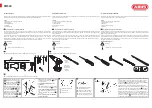
300M / 350M / 400M / 500M / 650M
22
- Fire can break out from sparks even several hours after the welding work has been finished.
1.3 INDIVIDUAL PROTECTION
1.3.1 Risks of external injuries
Arc rays produce very bright ultra violet and infrared beams. They will damage eyes and burn skin if the operator is not properly protected.
-The welder must be dressed and protected according to the constraints of his works impose to him.
-Operator must insulate himself from the work-pieces and the ground. Make sure that no metal piece, especially those connected to the network,
comes in electrical contact to the operator.
-The welder must always wear an individual insulating protection.
Protective equipments: gloves, aprons, safety shoes that offer the additional advantage to protect the operator against burns caused by
hot pieces, spatters, etc. Check the good state of this equipment and replace them before you are not protected any more.
- It is absolutely necessary to protect eyes against arc rays.
- Protect hair and face against sparks. The welding shield, with or without headset, must be always equipped with a proper filter according to the arc
welding current. In order to protect shaded filter from impacts and sparks, it is recommended to add a glass in front of the shield.
The helmet supplied with the equipment is provided with a protective filter. When you want to replace it, you must precise the reference
and number of opacity degree of the filter. Use the shade of lens as recommended in the following table (opacity graduation).
Protect others in the work area from arc rays by using protective booths, UV protective goggles, and if necessary, a welding shield with
appropriate protective filter on (NF S 77-104 – by A 1.5).
Current Amps
0,5
2,5
10
20
40
80
125
175
225
275
350
450
1
5
15
30
60
100
150
200
250
300
400
500
Welding process
Coated electrodes
9
10
11
12
13
14
MIG on heavy metals
10
11
12
13
14
MIG on light alloys
10
11
12
13
14
15
TIG on all metals
9
10
11
12
13
14
MAG
10
11
12
13
14
15
Air/Arc gouging
10
11
12
13
14
15
Plasma cutting
9
10
11
12
13
Depending on the conditions of use, the next highest or lowest category number may be used.
The expression “heavy metals” covers steels, alloyed steels, copper and its alloys.
The shaded areas represent applications where the welding processes are not normally used at present. .
NOTE: Use a higher degree of filters if welding is performed in premises, which are not well lighted.
1. 3.2 Risk of internal injuries
Gases and fumes
- Gases and fumes produced during the welding process can be dangerous and hazardous to your health. Arc welding works must be carried out in
suitable ventilated areas.
- Ventilation must be adequate to remove gases and fumes during operation. All fumes produced during welding have to be efficiently removed
during its production, and as close as possible from the place they are produced.
- Vapours of chlorinated solvents can form toxic gas phosgene when exposed to ultraviolet radiation from an electric arc.
Safety in the use of gases (welding with TIG or MIG inert gases)
Compressed gas cylinders
Compressed gas cylinders are potentially dangerous. Refer to suppliers for proper handling procedures:
- No impact: secure the cylinders and keep them away from impacts.
- No excess heat (over 50°C)
Pressure relief valve
- Check that the pressure relief screw is slackened off before connecting to the cylinder.
- Check that the union is tight before opening the valve of the cylinder. Open it slowly a fraction of a turn.
- If there is a leak, NEVER tighten a union under pressure, but first close the valve on the cylinder.
- Always check that hoses are in good condition.
















































